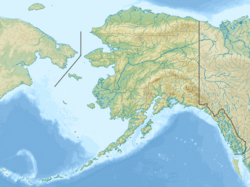Cape Mountain facts for kids
Quick facts for kids Cape Mountain |
|
|---|---|
| Highest point | |
| Elevation | 2,289 ft (698 m) |
| Geography | |
| Location | Seward Peninsula, Alaska, U.S. |
Cape Mountain is a cool peak located about 3 miles (5 km) southeast of Cape Prince of Wales. You can find it on the Seward Peninsula in Alaska, USA. A surveyor named Alfred Hulse Brooks gave it its name back in 1900.
Where is Cape Mountain?
Cape Mountain is a very important spot. It marks the northern end of the Continental Divide of the Americas. This is a line that separates which ocean rivers flow into. For a while, people even thought it was the westernmost point in the whole United States!
The mountain stands tall at 2,289 feet (698 meters) high. Its sharp peak rises about 2,000 feet (610 meters) above the York Plateau. There's also a clear flat area, like a bench, at 1,200 feet (366 meters). The eastern base of the mountain is lower than 500 feet (152 meters).
You can see a sharp, pointy rock formation on its western side. Two towns are nearby: Tin City is to the southeast, and Kingegan is to the northwest. Another town, Teller, is about 53 miles (85 km) to the southeast.
A stream called Cape Creek starts on the mountain's eastern side. It flows south for about 2 miles (3 km) until it reaches the Bering Sea at Tin City. Other smaller streams also flow from the mountain.
What is Cape Mountain Made Of?
Cape Mountain is mostly made of rocks called granite and porphyries. These rocks are very strong and have many cracks. If you look at a geology map, you'd see that the granite forms huge, solid blocks. This gives the mountain its unique shape.
The very top and the pointy parts of the mountain are granite. You can even see tiny crystals of feldspar in the rock. The granite is usually coarse, meaning it has large crystals. It's made of minerals like quartz, microcline, and biotite.
Scientists have found signs that glaciers once covered parts of the mountain. There's also a type of rock called limestone that might be part of the Kigluaik rock series. Some white limestone formations are thought to be "intrusives," meaning they pushed into older rocks.
Miners once dug a tunnel, called an adit, 418 feet (127 meters) long into Cape Mountain. They were looking for minerals. Inside, they found granite with a mineral called cassiterite. This rock formed during the Late Cretaceous period, a very long time ago! Scientists have figured out that the granite in Cape Mountain is about 78.8 million years old.
Minerals Found on Cape Mountain
People have explored Cape Mountain for valuable minerals, especially tin. Tin ore was first found here in July 1902 by W.C.J. Bartels. However, early attempts to mine it weren't very successful.
The mountain also has small amounts of naturally radioactive minerals. These include monazite, xenotime, and zircon. These minerals contain a tiny bit of uranium, which comes from thorium in the monazite. Scientists think these radioactive minerals are there because of the granite rocks or the tin deposits in the area.


